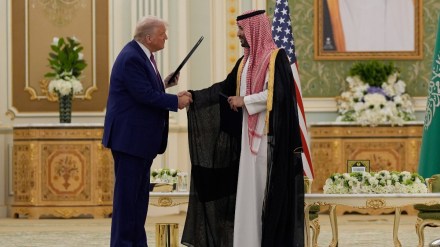As US President Donald Trump completed first day of his Middle-East visit, it turned out to be a day full of important announcements and signing deals with Saudi Arabia. Trump is on his first leg of a major diplomatic four-day tour to Saudi Arabia, Qatar and UAE. Let’s dive into the key takeaways from Trump and Saudi Crown Prince Mohammed bin Salman’s meeting.
Trump and Saudi Crown Prince sign $142bn (£107bn) arms deal
The United States and Saudi Arabia signed a major defence agreement on Tuesday, valued at nearly $142 billion, according to the White House. This deal will allow Saudi Arabia to buy advanced military equipment and services from American companies. The agreement is part of a larger plan by Saudi Arabia to invest $600 billion in the US, the White House said in a statement, as reported by Reuters. The deal also includes weapons, military systems, and support services.
Other billion dollar deals
Along with the defence deal, other commercial agreements were also signed. These include a $14.2 billion deal with General Electric for gas turbines and energy solutions, and a $4.8 billion deal for Boeing 737-8 passenger planes.
Trump announces removal of sanctions from Syria
In a significant move, Trump also announced that the announced that American sanctions on Syria will be lifted, marking a major shift in policy and offering significant support to the new government in Tehran, which took power following the ousting of longtime leader Bashar al-Assad in December.
“There’s a new government that will hopefully succeed in stabilising the country and keeping peace,” Trump said in Saudi Arabia on Tuesday, during the first day of his three-day trip to the Middle East, which also includes stops in Qatar and the United Arab Emirates. “I will be ordering the cessation of sanctions against Syria in order to give them a chance at greatness.”
Trump is also set to meet with Syria’s president, Ahmed al-Sharaa, in Riyadh on Wednesday, further indicating that the US believes it is time to end Syria’s international isolation.
Focus on strengthening US-Saudi relationship
Trump on Tuesday presented Saudi Arabia as an example of what a renewed and stable Middle East could look like. During his first major international trip as president, he focused on the idea that economic growth and opportunity could replace the ongoing conflict and unrest in the region.
Later in the day, in a wide-ranging speech that lasted an hour, Trump praised the Saudi crown prince and highlighted efforts by both nations to strengthen their ties, calling the partnership stronger than ever before.
Hopeful of joining Abraham Accords
Trump said he hoped Saudi Arabia would join the Abraham Accords — the deals he helped broker during his first term, where Israel made peace deals with other Gulf countries.
During his foreign policy speech at an investment summit in Riyadh, Trump expressed his strong desire for Saudi Arabia to join the Abraham Accords, saying, “It’s my fervent hope, wish and even my dream that Saudi Arabia… will soon be joining the Abraham Accords.”
He then added, “But you’ll do it in your own time,” recognising that Saudi Arabia may not be ready to normalise ties at the moment, especially with the ongoing conflict in Gaza and the Israeli government’s current stance on a future Palestinian state.
Trump hopes to make a deal with Iran, but it comes with a warning
Trump also said that he was open to making a new deal with Iran as nuclear talks continue. He stressed that such a deal could help make both the regions and the world safer. However, he also issued a strong warning to Iran’s leaders that if they reject his offer for peace, the US would respond with tough measures, including putting heavy pressure on Iran’s economy and cutting its oil exports to zero, as had been done in the past.
Trump made it clear that Iran would not be allowed to develop a nuclear weapon, but also said the country could have a much better future if it chose peace. He said that this offer would not be available forever and urged Iran to make a decision soon, as events were moving quickly.
He also described Iran as the most harmful force in the Middle East and blamed its government for causing instability across the region. Framing his message as both a final warning and a chance for diplomacy, Trump said Iran must choose between continuing its current actions or taking a new path toward peace.
